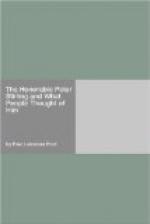Steele once wrote that the only difference between the Catholic Church and the Church of England was, that the former was infallible and the latter never wrong. Mr. Pierce would hardly have claimed for himself either of these qualities. He was too accustomed in his business to writing, “E. and O.E.” above his initials, to put much faith in human dicta. But in the present instance he felt sure of what he said, and the little group clearly agreed. If they were right, this story is like that recounted in Mother Goose, which was ended before it was begun. But Mr. Pierce had said that romance is everywhere to those who have the spirit of it in them. Perhaps in this case the spirit was lacking in his judges—not in Peter Stirling.
CHAPTER II.
Appearances.
The unconscious illustration of Mr. Pierce’s theory was pacing backwards and forwards on the narrow space between the cuddy-roof and the gunwale, which custom dignifies with the name of deck. Six strides forward and turn. Six strides aft and turn. That was the extent of the beat. Yet had Peter been on sentry duty, he could not have continued it more regularly or persistently. If he were walking off his supper, as most of those seated aft would have suggested, the performance was not particularly interesting. The limit and rapidity of the walk resembled the tramp of a confined animal, exercising its last meal. But when one stands in front of the lion’s cage, and sees that restless and tireless stride, one cannot but wonder how much of it is due to the last shin-bone, and how much to the wild and powerful nature under the tawny skin. The question occurs because the nature and antecedents of the lion are known. For this same reason the yachters were a unit in agreeing that Stirling’s unceasing walk was merely a digestive promenade. The problem was whether they were right? Or whether, to apply Mr. Pierce’s formula, they merely imposed their own frame of mind in place of Stirling’s, and decided, since their sole reason for walking at the moment would be entirely hygienic, that he too must be striding from the same cause?
Dr. Holmes tells us that when James and Thomas converse there are really six talkers. First, James as James thinks he is, and Thomas as Thomas thinks he is. Second James as Thomas thinks him, and Thomas as James thinks him. Finally, there are James and Thomas as they really are. Since this is neither an autobiography nor an inspired story, the world’s view of Peter Stirling must be adopted without regard to its accuracy. And because this view was the sum of his past and personal, these elements must be computed before we can know on what the world based its conclusions concerning him.




